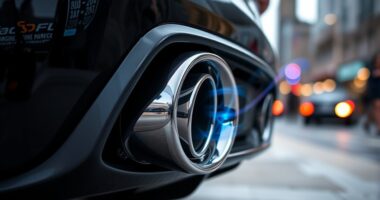When installing aftermarket lighting, you must follow federal, state, and local laws to stay compliant and safe. Confirm your lights meet standards like FMVSS 108 and have proper certifications such as DOT, SAE, or UL. Check brightness levels, color, and placement to avoid glare and penalties. Be mindful of regional restrictions on colors or flashing features. Staying compliant involves choosing certified products and proper installation—continued guidance can help you navigate these legal considerations effectively.
Key Takeaways
- Ensure aftermarket lighting complies with regional regulations, such as FMVSS 108 in the U.S. and UNECE standards internationally.
- Verify products have proper certifications (DOT, SAE, UL, ETL, DLC) to confirm safety, durability, and legal compliance.
- Maintain appropriate light performance, including brightness and color temperature, to prevent glare and meet legal standards.
- Follow installation best practices, including correct placement, wiring, and safety features, to avoid electrical hazards and legal issues.
- Stay informed of local laws regarding light colors, placement, and flashing patterns to ensure vehicle legality.
Regulatory Standards and Certification Requirements

To guarantee your aftermarket lighting is legal and safe, you need to understand the regulatory standards and certification requirements that apply. In the U.S., FMVSS 108 governs automotive lighting, setting rules for brightness, color, and placement to ensure visibility and safety. Your aftermarket LED lights must not interfere with existing vehicle lighting systems. Certification from the Department of Transportation (DOT) and adherence to SAE standards confirm that your lights meet safety, durability, and performance benchmarks. Many states also require these certifications for legality and resale. Keep in mind that regulations can vary by state; some restrict certain light types or colors. International standards like UNECE also influence product design for global markets. Ensuring compliance helps avoid inspections failure and legal penalties, keeping your modifications both safe and legal. Additionally, understanding lighting standards can help ensure your modifications meet all necessary legal requirements. It is also important to stay updated with mechanical failures and common issues that can affect the performance and safety of aftermarket lighting systems. Regularly checking for product recalls related to aftermarket lighting can further safeguard your vehicle and ensure ongoing compliance. Being aware of dog breed characteristics can assist in choosing the right lighting that suits your vehicle’s design and your needs. Staying informed about state-specific laws can help prevent inadvertent violations and fines.
Legal Implications of Light Performance and Brightness

Making certain your aftermarket lighting complies with legal brightness levels is essential to avoid fines and inspection failures. Federal regulations specify headlight luminous intensity between 500–3,000 candelas, with stricter limits in environmental zones after curfew. Brightness that exceeds these standards can cause glare, impairing visibility and safety. Non-compliant lights may lead to penalties, including fines, inspection failures, or mandatory modifications. To stay compliant, consider:
Ensure your aftermarket lights meet legal brightness standards to avoid fines and safety issues.
- Using photometric testing to verify lumen output
- Avoiding uncertified or non-DOT/SAE/E-mark components
- Ensuring proper beam alignment and pattern
- Monitoring color temperature to prevent excessive blue-white glare
- Recognizing that lighting performance can be applied when designing compliant lighting solutions to balance performance with legal standards
- Additionally, understanding the contrast ratio helps in designing lighting that minimizes glare while maintaining visibility, ensuring safety and compliance. Proper light distribution and beam pattern design are crucial for meeting legal requirements and reducing glare issues, further promoting safety on the road. Incorporating regulatory standards during the design process can help ensure your lighting system remains compliant and effective, avoiding potential legal issues.
Installation Practices and Safety Compliance

Proper installation of aftermarket lighting requires strict adherence to certification standards, electrical system compatibility, and safety protocols. You must ensure that components meet UL, IEC, and ANSI standards for electrical safety, and verify RoHS compliance to restrict hazardous materials. Using fixtures with appropriate IP ratings safeguards against moisture and dust, especially in outdoor environments. Compatibility checks include circuit load calculations, voltage matching, and verifying GFCI or AFCI breaker requirements for wet locations. Follow NEC guidelines for fixture placement, junction box sizing, wire gauge, and strain relief to prevent hazards. Always use insulated tools, implement lockout/tagout procedures, and maintain proper thermal clearance. Conduct post-installation tests like voltage drop and ground continuity to confirm safety and compliance, reducing legal risks and ensuring reliable performance. Additionally, integrating safety features such as circuit breakers and surge protectors can further enhance the safety and longevity of the lighting system. It is also important to stay updated with evolving installation practices and regulations to maintain compliance and ensure optimal system performance.
State and Local Regulations Impacting Aftermarket Lights

State and local regulations considerably influence what aftermarket lighting modifications you can legally make to your vehicle. These laws vary widely and can restrict color, placement, and certification standards. For example, some states prohibit certain colors, like red and blue, for non-emergency vehicles, while others permit compliant LED headlights and underglow. Certification is often required, with states like Hawaii and Florida mandating DOT or SAE approval to ensure safety and legality. Local ordinances can sometimes enforce stricter rules, especially in urban areas or specific jurisdictions. Keep in mind:
State and local laws heavily regulate aftermarket vehicle lighting modifications for safety and compliance.
- North Carolina bans red/blue lights except for emergency vehicles
- California restricts front-visible red lighting and mandates headlight use with wipers
- Illinois implicitly bans neon/LED underglow
- Florida enforces DOT compliance and regulates underglow flashing patterns
- Synthetic lighting options are subject to different regulations depending on the jurisdiction. Additionally, staying informed about vehicle lighting laws can help prevent costly penalties and ensure your vehicle remains compliant with all applicable regulations. Understanding regulatory standards can also assist in choosing lighting that meets safety requirements and avoids potential legal issues. For example, some jurisdictions may require specific certification standards for aftermarket lights to ensure they meet safety requirements. It is also important to consider existing vehicle modifications to avoid interference with aftermarket lights and maintain safety standards.
Always verify your area’s specific laws before modifying your vehicle.
Choosing Quality Products to Ensure Legal and Safe Operation

Selecting high-quality aftermarket lighting products is essential to stay within legal boundaries and guarantee safe operation. Look for certifications like UL Listed or ETL, which verify electrical safety and compliance with North American standards. DLC Premium V5.1 ensures glare reduction, color consistency, and energy efficiency, qualifying your lights for rebates. Energy Star certification confirms energy savings and long-term performance, while RoHS compliance guarantees the absence of hazardous substances. FCC certification minimizes electromagnetic interference, protecting communication systems. Prioritize products with high lumens per watt, CRI ≥80 for accurate color rendering, and lumen maintenance above 90% for longevity. Check for documented performance data, warranties of at least five years, and environmental ratings like IP65. Confirming controllability features such as dimmability and compatibility with smart protocols helps integrate lights smoothly and safely. Additionally, selecting security zone info approved products can help ensure compliance with specific regional security standards. Incorporating ethical hacking principles into your security protocols can also enhance the safety and resilience of your lighting control systems. Ensuring your lighting systems utilize secure network protocols can further prevent unauthorized access and potential vulnerabilities. Conducting regular product testing and maintenance is crucial for sustained legal compliance and safety. Always verify that the products meet regional lighting regulations to avoid legal complications and penalties.
Frequently Asked Questions
How Do I Verify if Aftermarket Headlights Are Legally Compliant?
You want to verify if aftermarket headlights are legal. Start by checking for proper certifications like DOT/SAE labels for the U.S. or E-mark for Europe. Confirm the manufacturer labels and confirm the headlights meet brightness, beam pattern, and color temperature standards. Verify compatibility with your vehicle, avoid modifications, and consider professional installation. Finally, review local regulations, schedule inspections if needed, and keep documentation to prove compliance.
Can I Legally Modify My Headlights for Off-Road Use Only?
You can modify your headlights for off-road use only, but you need to follow specific rules. Make sure the modifications are clearly marked “For off-road use only” and that they don’t interfere with your vehicle’s on-road safety features. Check your local laws, as some states require covering or disabling these lights when on public roads. Always guarantee your modifications meet safety standards and don’t cause hazards for other drivers.
What Are the Penalties for Installing Non-Compliant Aftermarket Lighting?
You might think installing non-compliant aftermarket lighting is harmless, but the risks are real. Penalties can hit hard—fines, mandatory removals, and even legal trouble. State laws might be stricter, adding to the danger. If caught, you could face hefty costs and safety hazards. Don’t gamble with your vehicle’s legality or safety—staying compliant protects you from penalties and keeps everyone safe on the road.
Do Aftermarket LED Headlights Affect My Vehicle’S Insurance Coverage?
You should know that aftermarket LED headlights can impact your insurance coverage if you don’t disclose them. Insurance policies often require written approval for certain modifications, and failure to inform your insurer might invalidate your policy. Additionally, illegal retrofits could cause MOT failures or claims denials. To stay covered, always check your insurer’s rules, get approval for upgrades, and confirm your lights meet legal standards.
Are There Specific Certifications Required for Aftermarket Lights in Different States?
You wanna upgrade your car’s lights, but beware—certifications vary across states. While federal standards like FMVSS 108, SAE, and DOT guarantee safety and compliance, some states like California and Texas impose stricter rules. You need to check local laws on photometric performance, color restrictions, and approval labels. Failing to do so risks inspection failures, fines, or insurance issues. Stay informed, get certified, and ensure your aftermarket lights meet your state’s requirements.
Conclusion
So, while it might seem tempting to skip the paperwork and go for that flashy new light, remember—breaking the rules can leave you in the dark when it counts. Ironically, choosing legally compliant, quality aftermarket lighting not only keeps you safe but also saves you from costly fines and headaches down the road. After all, the brightest idea isn’t always the one that shines the most—sometimes, it’s the one that stays within the lines.










